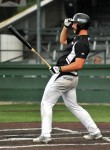Warner’s perspective key in baseball, CSI career path – Sedalia Democrat
Andrew Warner steps into the batters box Wednesday, July 26 during a MINK League Playoff game against Clarinda.
Photos by Alex Agueros | Democrat
A set of fingerprints photographed by Andrew Warner for his criminal justice major at Columbia College. Warner said attention to detail is a quality helpful to both crime scene investigation and baseball.
Photo courtesy of Andrew Warner
Andrew Warner, left, laughs with a Chillicothe opponent on first base. Warner studies criminal justice at Columbia College. He has six home runs, 17 walks and 15 strikeouts in 24 games this summer.
Photos by Alex Agueros | Democrat
Sedalia Bombers slugger Andrew Warner has a good eye.
Bearded and 6-foot-2, Warner lumbers to the plate to the sounds of Marvin Gaye and leans back to examine the defense. There is a hearty smack when he squares up a pitch, often not in proportion to a swing that appears effortless, like a flick of the wrist.
With the season at stake in the MINK League Playoffs, Warner walked and scored twice and drove the game-winning double far enough for Trey Harris never the fastest in a lineup to score from first.
From swatting homers to taking walks, Warners plate discipline is a product of sharp vision. He brings the same attention to detail to crime scene investigation photography as a criminal justice major at Columbia College.
Im just seeing (the ball) well, Warner said. Feeling good, finally.
A knee injury relegated Warner to a designated hitters role for Sedalia. Hes just happy to have work. Entering his senior year at Columbia College, Warner made stops at Johnson County Community College and Longview Community College before joining the Cougars and Bombers coach Craig McAndrews for its inaugural season last spring.
I couldnt be happier where Im at, Warner said. People always debate over Division I, Division II, NAIA, all that I couldnt care less about that. Im getting a great education and get to play the game I love. Thats awesome.
Warner made his first rounds at Liberty Park in high school, playing a district tournament game for Lees Summit North. He remembered hitting the 375-foot sign in center field and taking walks the rest of the game. Not much has changed.
In just 24 games, Warner has six home runs, more walks than strikeouts and is runner-up in team RBIs to Dalton Horstmeier. Horstmeier leads the MINK League with 47 RBIs in 38 games.
Warner would prefer to keep making rounds in Sedalia. He said Sedalia, or a town its size, is his ideal work environment as an officer or detective.
Its peaceful, quiet, Warner said. I wouldnt want to work in Columbia There are too many kids.
Given his easy-going attitude, it appears Warner could work anywhere. With a criminal justice degree and CSI certificate, hell be well-read in the world of forensics and crime scene photography. Shutter speed, filters, exposure and focus are details considered when producing credible evidence in court. He also appears to get along with everyone, joshing with opponents at first when he does get on the field.
One lesson growing on Warner is how to lead.
Were going to have new guys at Columbia College next year, and, being with all these people Ive never played with before Ive molded pretty well with everybody here, Warner said. The whole team has come together. Im going to be a senior, so I have to come in and try to be a senior. (The Bombers) have shown me how to bring people together.
Andrew Warner steps into the batters box Wednesday, July 26 during a MINK League Playoff game against Clarinda.
http://www.sedaliademocrat.com/wp-content/uploads/2017/07/web1_Bombers-Warner_1.jpgAndrew Warner steps into the batters box Wednesday, July 26 during a MINK League Playoff game against Clarinda. Photos by Alex Agueros | Democrat
A set of fingerprints photographed by Andrew Warner for his criminal justice major at Columbia College. Warner said attention to detail is a quality helpful to both crime scene investigation and baseball.
http://www.sedaliademocrat.com/wp-content/uploads/2017/07/web1_Bombers-Warner_3.jpgA set of fingerprints photographed by Andrew Warner for his criminal justice major at Columbia College. Warner said attention to detail is a quality helpful to both crime scene investigation and baseball. Photo courtesy of Andrew Warner
Andrew Warner, left, laughs with a Chillicothe opponent on first base. Warner studies criminal justice at Columbia College. He has six home runs, 17 walks and 15 strikeouts in 24 games this summer.
http://www.sedaliademocrat.com/wp-content/uploads/2017/07/web1_Bombers-Warner_2.jpgAndrew Warner, left, laughs with a Chillicothe opponent on first base. Warner studies criminal justice at Columbia College. He has six home runs, 17 walks and 15 strikeouts in 24 games this summer. Photos by Alex Agueros | Democrat
Alex Agueros can be reached at 660-826-1000, ext. 1483 or on Twitter @abagueros2
.

Read more from the original source:
Warner's perspective key in baseball, CSI career path - Sedalia Democrat